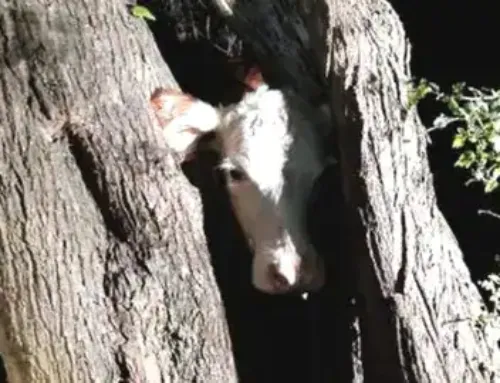At the turn of the 20th century, there were about 350,000 deer left in America. Unregulated market hunting for hides and venison had decimated the herds, and while it seems unthinkable today, the whitetail was on the way to extirpation.
In the early 1900s, the first forward-thinking wildlife managers saw it coming, and so they established state game laws and banned the sale of venison. Their vision saved the whitetail, and is our #1 conservation achievement. We have an estimated 35 to 40 million whitetails in the U.S. today.
NOTE HERE: In recent blogs I have spoken to reduced deer numbers and harvests in some regions, especially across the upper Midwest, as a result of EHD, predators, hard winters and doe bag limits that got too liberal as the herds exploded over the years. But I have always pointed out that the deer depression is not occurring everywhere. Conversely, in many suburban areas in the East, from New Jersey and Connecticut to D.C. to Atlanta, there are way too many deer living in peoples’ backyards, and that is sparking an entirely different debate.
Last October The Wildlife Society, a conservation group of 10,000 scientists, wildlife managers and academics, floated the idea allowing the sale of wild venison in the overpopulated areas as an “incentive” to reduce the deer numbers and the extensive damage they can cause.
This is not some cockamamie scheme. As the Wall Street Journal reported, the idea came from a peer-reviewed article–“Regulated Commercial Harvest to Manage Overabundant White-Tailed Deer”–An Idea to Consider?” written by 7 respected wildlife ecologists and published in the Society’s scientific quarterly.
“the new incentive would involve targeting overabundant whitetails in neighborhoods, parks, townships…by specially qualified shooters. Hired sharpshooters already perform this task in many places, at taxpayer expense. The difference is that, instead of being donated to food pantries or sent to landfills, the venison and byproducts could be sold, perhaps as a locavore delicacy, to recoup some costs.”
When the Wildlife Society floated the idea, they figured most people would be against it. Some are. But turns out many professionals and fed-up suburbanites with too many deer living around their homes and causing trouble seem willing to at least look at the idea of opening up the sale of wild venison again.
One wildlife ecologist said the commercial harvest of deer “would simply add another tool to our toolbox” but not affect our sport hunting. Proponents note that trapping and selling wild fur-bearers is allowed, as is catching and selling both freshwater and saltwater fish.
And a recent poll in New Jersey asked the question: Would you favor the commercial hunting of deer in New Jersey? While 51% said no, a surprising 45% answered yes.
While this idea has been out there for a couple of years, most people doubted whether a state government would be willing to step up and try it.
But in March New Jersey Republican Assemblywoman Caroline Casagrande said she will be introducing a bill that directs the state Division of Fish and Wildlife to develop and establish requirements for the commercial harvesting of deer. “This will be controversial but the Wall Street Journal had an article that said 85 percent of the venison sold in restaurants and at meat counters is imported from farms in New Zealand. It’s insane we’re importing it from New Zealand. Meanwhile, we’re overrun with deer… I hold my breath every time I get on the road. Instances of Lyme disease are a major problem.’’
Could this actually happen? Maybe. For the last 30 years people living in Eastern suburbs have been trying to deal with too many deer that destroy their plants and trees, overgraze state parks, cause car wrecks, carry tick disease, etc. Fences, repellants, birth-control experiments and special bow seasons have not controlled the herds. People are fed up. If selling venison to restaurants in nearby cities will offset the cost of bringing in shooters to kill more deer, many people might want to try it, especially since the meat would not be wasted.
I have lived and hunted in the northern Virginia suburbs, and have seen first-hand the damage caused by too many deer. But I am against this.
Many people would say that deer hunting is already way too commercial. Imagine putting more money and profits into the transport, butchering and sale of deer meat. Who would regulate the shooters, the sellers, the meat markets, the restaurants? Another government program with fraud and waste? Would the FDA get involved? Could poachers infiltrate the system and randomly kill and sell deer?
The professionals say that limited commercial hunting would supplement and not affect the sport hunting opportunities of the locals in an area, but how can they know that? Seems logical to me that a DNR might have to tweak the hunting season and bag limits in an area where the commercial shooting of deer would be going on.
Besides, the last best thing we have in hunting is going out into the woods on a chilly fall day, killing a deer, gutting it, dragging it home and feeding our family with wonderful, deep-red venison…or donating that meat to a food bank for the less fortunate to enjoy. Do we want to exploit that? We start putting money and profit in it, we change the game.
What do you think about commercial hunting and the sale of venison?







Mike: Let us be honest are there not a lot of people making the almighty dollar off deer already? Why is anyone surprised at the progression to the selling whitetail meat from legally harvested deer?
We already have leased land, more hunting accessories than I could begin to list, guides, even writers and TV producers such as yourself, etc., etc. with no end of the commercialism of whitetails in sight.
Sadly gone for the most part are the days of Woolrich, the old hunting shack, walk out your back door and hunt anywhere you please then work your way home for lunch back here in the east.
As I said in the post, “Many people would say that deer hunting is already way too commercial…”
This is an interesting article and debate. I don’t think even if all suburban areas opened up to bow hunters and crossbow hunters it would still make a difference. There just are not enough bow hunters to manage these areas. Not every hunter is out for meat and/or wants to take that many does for their freezer.
I am not sure about the selling of meat. If it was done, it would have to be heavily regulate and i agree that poaching and black market sale would start to cause issues with regular hunters and those who are following the law.
Jason
The solution for overabundance of deer is and always has been giving hunters as much opportunity as possible in those areas. Archery, crossbows, rifles, extended seasons, open up public lands, state parks, and city municipal areas. Allow night hunting if absolutely necessary.
But not commercial sale. In a vacuum, it would work, but the ripple effect will have many unintended consequences.
Quote from the article…..”But turns out many professionals and fed-up suburbanites with too many deer living around their homes and causing trouble seem willing to at least look at the idea of opening up the sale of wild venison again.”
Maybe if these people who are “fed-up” with the deer would allow bowhunting in their suburban neighborhoods there wouldn’t be so many deer. That wouldn’t cost them a dime and the hunters could eat the meat or donate it.
Or they can take their HOA dues/fees and pay for sharpshooters to do the same thing and then deal with the FDA and all the regs that go with selling food products.
Commercial sale of wild deer……..NO! No way, and Not a chance in hell I would ever go for that one! You talk about people using their good common sense to manage the deer herd so it is viable and stable for years to come and then throw dollar bills to be made on the meat! We wouldn’t be hunting deer very long and the young guns would have no chance at all to experience the rush of a big bonehead easing towards them on a hunt. Unless of course they went to a deer farm and settled the gun in on a fencepost for the 20 yard shot it would take to down the $15000 dollar trophy! Count me out on this one!
Mike, I am sure you have heard of catfish farm, talipia farm, hog farm, beef (cow) farm, and poultry farms. I have heard of alligator farms but not sure how that work while gator hunters has to follow strict rules. Back to the point, can you imagine deer farms growing all over the country just to meet the demand of restaurants? I hope it will never happen as long as I live. I shudder to think of EHD and whatever else could come out of deer farms. I have seen what happened with commercial crabbing industries wiping out the blue crab population easily in MD/VA area.
Mike I think this idea is thought of with good intentions by some city folks, but at the same time do they not see the large downside to it? I mean think about if deer meat had a value of $20 a pound, and you could get 60lbs of meat from a big doe. That one single deer is now worth 1200 dollars! Poaching would go through the roof with all the people trying to get their hands on kind of money, look at the trouble people go through to get copper and just imagine how much easier it would be for them to spotlight a deer. I’m not worried about our populations being decimated as they were at the turn of the 20th century because I think we have learned from that mistake, but I am worried about what it would do to our sport and the way it would change hunting if you could sell venison.
No way I’d ever condone this answer to the question of too many deer. Something has to be done but I think it is up to city and county governments to find another answer to the question. There are up to 1000 deer and 2000 hogs in an area just outside of Houston, where I live, called Barker Reservoir. Hogs destroy property in a way deer don’t even come close to. Yet the county government won’t even listen to suggestions that hunters be allowed to bow or Xbow hunt in this 20000 acre wilderness. Deer are everywhere around the Houston International airport. It’s dangerous to drive at night. Anyone got any suggestions?
Buy a heavy duty brush guard. lol You’re right about the hogs Rodger I don’t know what the government is going to do in order to get a hold of the pig population in the southern U.S. They breed as fast as you can kill them and the damage they do can really hurt a farmers livelihood. There are many game preserves that are way too overpopulated like the Reservoir you mention here, but the ecologist keep refusing to let hunters manage those areas and in turn the population keeps growing there.